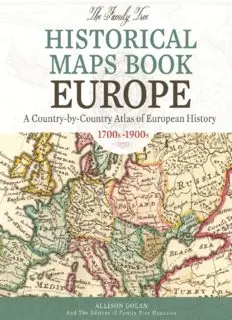
Family Tree Historical Maps Book: Europe: a Country-by-country Atlas of European History, 1700s-1900s PDF
Preview Family Tree Historical Maps Book: Europe: a Country-by-country Atlas of European History, 1700s-1900s
The Family Tree HISTORICAL MAPS BOOK EUROPE A Country-by-Country Atlas of European History, 1700s-1900s ALLISON DOLAN And The Editors of Family Tree Magazine Cincinnati, Ohio shopfamilytree.com CONTENTS I NTRODUCTION E UROPE I RELAND S COTLAND E W NGLAND AND ALES S P PAIN AND ORTUGAL F RANCE I TALY B : B • L • N ENELUX ELGIUM UXEMBOURG ETHERLANDS S D • F • I • N • CANDINAVIA: ENMARK INLAND CELAND ORWAY S WEDEN G S ERMANY AND WITZERLAND A H USTRIA AND UNGARY C R S ZECH EPUBLIC AND LOVAKIA R B OMANIA AND ULGARIA B S : A • B H • ALKAN TATES LBANIA OSNIA AND ERZEGOVINA C • S • S ROATIA ERBIA LOVENIA G REECE P OLAND R E : B • E • L • USSIAN MPIRE ELARUS STONIA ATVIA L • R • U ITHUANIA USSIA KRAINE M ODERN MAP OF EUROPE A D DMINISTRATIVE IVISIONS I C NDEX AND REDITS INTRODUCTION BRAN, ROMANIA “A good map is both a useful tool and a magic carpet to faraway places.” — Anonymous Early in my career, I worked in Bucharest, Romania, as an English editor for Romanian tourism magazines. That job allowed me to travel all across Europe—and learn geography and history that would prove unexpectedly useful in my future genealogical endeavors, as well as my work at Family Tree Magazine. For example, one weekend jaunt took me to Bran Castle, popularly known as “Dracula’s Castle” (although Vlad “the Impaler” Tepes, the inspiration for Bram Stoker’s character, never actually lived there). The town of Bran sits in Brasov County, within the Transylvania region. To find Bran on a nineteenth-century map, you’d need to look at Hungary, not Romania: Transylvania was part of the Austro-Hungarian Empire until after World War I, when the region was awarded to Romania. Other areas of what’s now Romania were in the Ottoman and Russian empires during the 1800s. In fact, Romania didn’t exist as a nation at all until 1878. Romania isn’t alone in its absence from nineteenth- century maps. Many of the nations in Europe today weren’t “born” until relatively recently—think the Czech Republic, Slovakia, the Balkan States, Ukraine, Belarus, and the Baltics. Germany as we know it didn’t become a unified nation until 1871; Italy, not until 1861. Then there’s the historical tug of war over border territories such as Alsace-Lorraine, fought over by Germany and France. Although France ultimately won the territory, this visitor to Strasbourg couldn’t mistake the German influence on the city’s architecture and local cuisine. All these complications can trip up genealogists researching European ancestors. Even the most basic researching European ancestors. Even the most basic question—which country was the old country for my family?—doesn’t always have a straightforward answer. Maybe your third-great-grandfather’s passenger list says he came from Russia, but his village now is in Poland. Enter the Family Tree Historical Maps Book: Europe, a compendium of old maps designed specifically for genealogists trying to unravel these complexities. The 200-plus maps inside span the 1700s to the 1900s, when most European immigration to America took place— allowing you to visualize your ancestors’ homeland when they left it, and see how borders and jurisdictions changed over time. We’ve grouped the maps by country for easy reference, and ordered the chapters geographically so that adjacent nations are also near each other in the book: The Germany and Switzerland chapter, for instance, is next to Austria and Hungary, just as they are on a map. Within each section, maps are presented chronologically. We selected primarily English-language maps in recognition of our English-speaking audience: Mastering unfamiliar geography is tricky enough without accounting for additional languages. For untangling the variations in foreign place names, we advise using a gazetteer (place-names dictionary) focused on your ancestor’s country. I also highly recommend the Historical Atlas of Central Europe by Paul Robert Magocsi (Washington State University Press) as a supplemental reference for that region. To aid your understanding of the maps herein, as well as the lay of your ancestors’ homeland, this book includes a country-by-country listing of administrative divisions. You can download an expanded version of this directory from our website <ftu.familytreemagazine.com/administrative- divisions-europe>. The book’s large format helps give you both the big- picture and small-detail view. Each map shows the entire country or region while maximizing the readability of labels such as cities, counties, and geographic features. Of course, it’s impossible for a book like this to show every speck of the often-incredible level of detail in these old maps. But the complete index in the back of the book will help you locate maps of interest for viewing online in greater depth. Many of the maps in this volume come from the amazing David Rumsey Map Collection <www.davidrumsey.com>, whose website has a special viewer that lets you zoom in to a stunning level of detail. Other sources include the Library of Congress’ Geography and Map Division and the treasure trove of digitized materials on Wikimedia Commons. Thanks to these organizations’ work preserving and sharing old maps, we can explore our ancestors’ world today. Turn the page to begin your time-travel adventure. Allison Dolan PUBLISHER & COMMUNITY LEADER Family Tree Magazine
